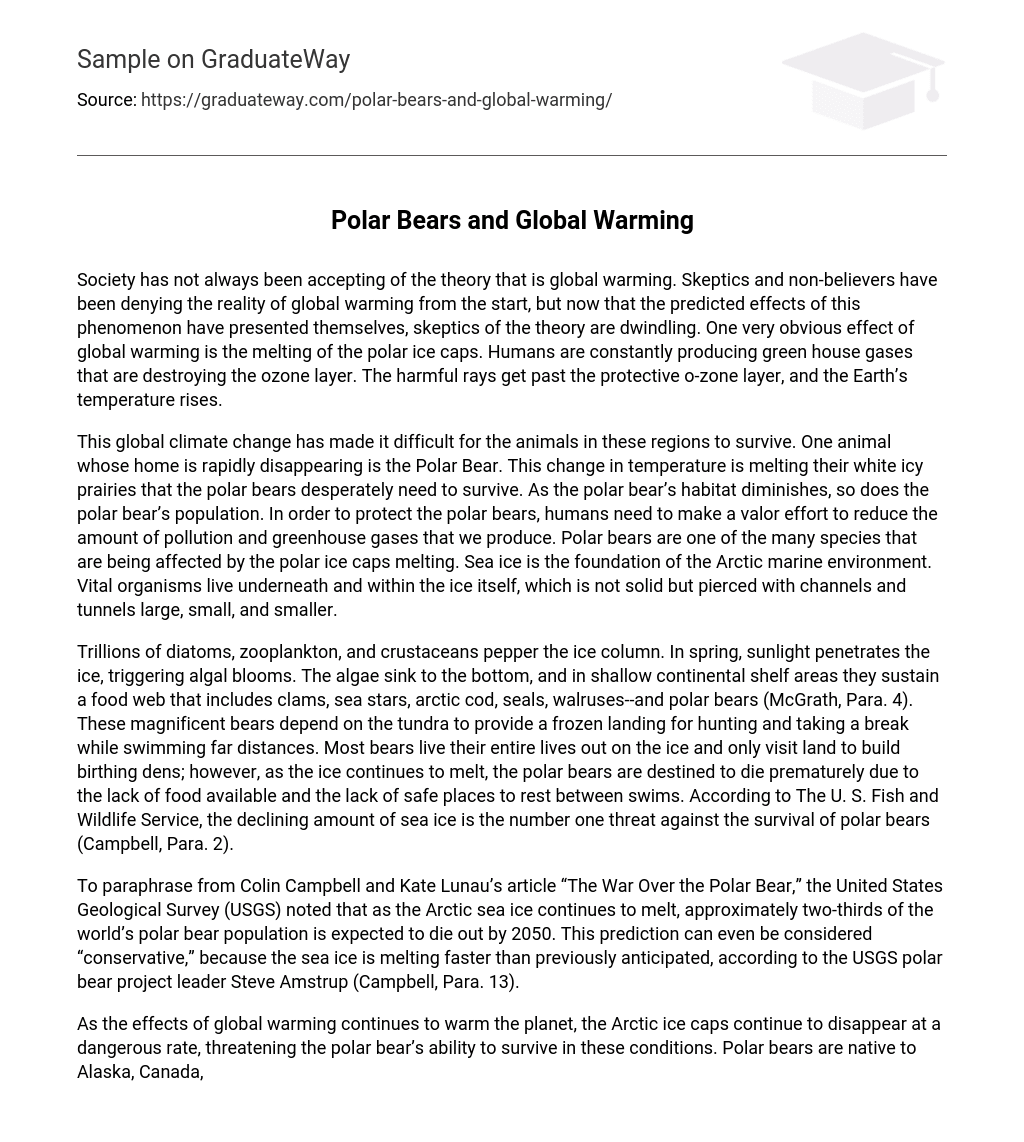Society has not always been accepting of the theory that is global warming. Skeptics and non-believers have been denying the reality of global warming from the start, but now that the predicted effects of this phenomenon have presented themselves, skeptics of the theory are dwindling. One very obvious effect of global warming is the melting of the polar ice caps. Humans are constantly producing green house gases that are destroying the ozone layer. The harmful rays get past the protective o-zone layer, and the Earth’s temperature rises.
This global climate change has made it difficult for the animals in these regions to survive. One animal whose home is rapidly disappearing is the Polar Bear. This change in temperature is melting their white icy prairies that the polar bears desperately need to survive. As the polar bear’s habitat diminishes, so does the polar bear’s population. In order to protect the polar bears, humans need to make a valor effort to reduce the amount of pollution and greenhouse gases that we produce. Polar bears are one of the many species that are being affected by the polar ice caps melting. Sea ice is the foundation of the Arctic marine environment. Vital organisms live underneath and within the ice itself, which is not solid but pierced with channels and tunnels large, small, and smaller.
Trillions of diatoms, zooplankton, and crustaceans pepper the ice column. In spring, sunlight penetrates the ice, triggering algal blooms. The algae sink to the bottom, and in shallow continental shelf areas they sustain a food web that includes clams, sea stars, arctic cod, seals, walruses–and polar bears (McGrath, Para. 4). These magnificent bears depend on the tundra to provide a frozen landing for hunting and taking a break while swimming far distances. Most bears live their entire lives out on the ice and only visit land to build birthing dens; however, as the ice continues to melt, the polar bears are destined to die prematurely due to the lack of food available and the lack of safe places to rest between swims. According to The U. S. Fish and Wildlife Service, the declining amount of sea ice is the number one threat against the survival of polar bears (Campbell, Para. 2).
To paraphrase from Colin Campbell and Kate Lunau’s article “The War Over the Polar Bear,” the United States Geological Survey (USGS) noted that as the Arctic sea ice continues to melt, approximately two-thirds of the world’s polar bear population is expected to die out by 2050. This prediction can even be considered “conservative,” because the sea ice is melting faster than previously anticipated, according to the USGS polar bear project leader Steve Amstrup (Campbell, Para. 13).
As the effects of global warming continues to warm the planet, the Arctic ice caps continue to disappear at a dangerous rate, threatening the polar bear’s ability to survive in these conditions. Polar bears are native to Alaska, Canada, and Russia. The bears that live in the Norwegian archipelago of Svalbard, the Beaufort Sea, and Hudson Bay in Northeast Canada have been studied the longest. The western part of the Hudson Bay is where the ice is known to melt in the summer and freeze back in the fall.
This is where the polar bears threat was first brought to light because as the years went on, and the planet continued to warm. The ice ceased to freeze back, making it difficult for the new mothers and baby cubs to survive the farther swims to find an frozen prairie where they could hunt and rest. As the distances between frozen arctic caps increases, so does the number of bears that drown. Although polar bears are good, strong swimmers, they are not as well fed as they used to be, due to the lack of hunting land.
As survival becomes less likely, fewer females give birth and fewer cubs actually survive. The polar bear’s predicament is a controversial topic, because in order for the government to put polar bears on the endangered species list, they would have to admit that global warming is real and is happening right now. However, this is a time pressing matter, because within the next 50 years, the polar bear species could be wiped out completely.
Global warming is the main cause of the problem at hand. If humans were able to limit the amount of green house gases that we release, maybe we could slow the warming of the planet and stop the ice caps from melting and never reforming. As long as the polar bears have ice caps to hunt on and rest on in between swims, less polar bears would die from starving or drowning. Slowing this death rate would increase the amount of cubs born each year and the survival rate would increase as well.
The polar bears can be saved, but its up to humans to slow the rate of global warming and its harmful effects. As global warming continues to progress, the polar bears continue to live with the threat of extinction in the near future.
Works Cited
- Campbell, ColinLunau, Kate. “THE WAR OVER THE POLAR BEAR. (Cover Story). “
- Maclean’s 121. 4/5 (2008): 46. MasterFILE Premier. Web. 17 Feb. 2013. McGrath, Susan.
- “On Thin Ice. ” National Geographic 220. 1 (2011): 63. MasterFILE Premier. Web. 17 Feb. 2013.





